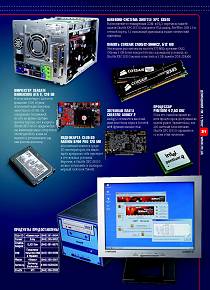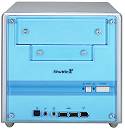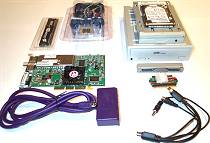
|
Achtung: Die aktuelle
Shuttle-Website finden sie unter http://www.shuttle.com
! Diese Website enthält Archivdaten, deren Aktualität nicht gewährleistet werden kann. |
| Produkte | Support | Index |
|
|||||||||||||||
| Unterkapitel: Spezifikation | Zubehör | Mainboard FS51 | Download | Info/FAQ | Bilder | Presse | | |||||||||||||||
|
|
Dinside.no Norway www.dinside.no/... 17. Febr. 2004 | Komplettsystem basierend auf Shuttle's XPC SS51G vorgestellt in der Kategorie: "Die besten PC-Angebote im Februar". Platzsparendes und praktisches Gehäuse |
 ClubDoHardware Brazil: Very interesting concept, very pretty
ClubDoHardware Brazil: Very interesting concept, very pretty
ClubDoHardware Brazil www.clubedohardware.com.br/... 26. June 2003 | Conclusions (Translation): The concept of the XPC is very interesting: a compact PC with modern and extremely quiet appearance. Its visual aspect is very pretty. In our tests, the general performance of the tested model (SS51G) was similar to other top-mainboards, what it is very good. (...) although it is a compact form factor you will be capable to get a good 3D performance when installing a graphics card in it. (...) the XPC is compact and with modern appearance, very pretty. |
 Home PC Ukraine: A home user's dream came true!
Home PC Ukraine: A home user's dream came true!
 Computerbase.de: Empfehlung der Redaktion
Computerbase.de: Empfehlung der Redaktion
Computerbase.de www.computerbase.de/... 6. August 2002  | Empfehlung der Redaktion Zugegeben, das SS51G hat uns mehr als nur beeindruckt. Galten Mini-Barebones bisher als eher langsamere Vertreter ihrer Zunft, ist es Shuttle gelungen, die alteingesessenen Fesseln zu sprengen. Zwar bietet die integrierte Grafik der Marke SiS315 eher übliche und deshalb relativ bescheidene Kost. Käufer des SS51G werden jedoch ohnehin auf den seperaten AGP-Slot setzen und dieser ermöglicht dem System endlich den Aufstieg zu seinen Verwandten, den Tower-PCs. Unserem Testsystem mit 2,4GHz Pentium 4 (533) und GeForce 3 Ti200 war es so vergönnt, in einigen Disziplinen den vergleichbaren Systemen die Show zu stehlen und dank DDR333 sogar am Thron des Rambus zu wackeln. Wer angesichts der minimalen Ausmaße des Aluminium-Käfigs nun an eine Reihe von Komplikationen denkt, wird enttäuscht. Shuttle hat es verstanden, das Gehäuse so benutzerfreundlich wie nur möglich zu gestalten. Die Installation sämtlicher Komponenten inklusive Kühlung ist ein Kinderspiel und selbst eine hochgezüchtete GeForce 4 Ti4600 mit ihren gigantischen Ausmaßen passte ohne Probleme in das System. Sollte Leistung ihren Preis haben, so wird dieser beim SS51G mit Sicherheit nicht durch das Design bezahlt. Denn auch hier überzeugte uns das Mini-Barebone auf ganzer Linie. Aluminium gepaart mit Acryl dürfte so ziemlich jederorts ein Hingucker werden und schont zudem das Gewicht. Auch die Beschriftung der Ports als auch die Kabelführung dürfen als vorbildlich angesehen werden. Ganz besonder überrascht hat uns im Endeffekt die Kühlung. Zwar hatten wir mit einer hohen Effektivität gerechnet. Dass die I.C.E. (Integrated Cooling Engine) unseren Pentium 4 im Seti@Home-Stresstest jedoch ohne Problem und unter einer äußerst angenehmen Geräuschkulisse auf gut 58°C hält, hätten wir nicht gedacht. In Zusammenarbeit mit dem leisen Netzteillüfter präsentiert sich die Kühlung somit als einer der wirklich großen Pluspunkte des Systems. Allerdings sollte hierbei bedacht werden, dass eine GeForce-Karte für den ambitionierten Spieler dieses Bild je nach Lüfter deutlich verfälschen kann. Dies ist jedoch in jedem Silent-PC der Fall. Und wie sieht es mit negativen Aspekten aus? Mager. Sehr mager. Bedenkt man die Größe des Systems und die damit einhergehenden Einschränkungen im Design (Laufwerke), fallen nicht wirklich negative Punkte ins Auge. Einzig und allein das Bios könnte in späteren Versionen noch um feinfühligere Möglichkeiten zur Einstellung der Speichertimings erweitert werden, um auch wählerische Module mit den besten Settings fahren zu können. Und wie sieht es mit dem Preis aus? Der liegt mit knapp 439€ zwar recht hoch, für exklusive Ware musste jedoch schon immer etwas mehr Geld den Besitzer wechseln. Und wir sind der Meinung, dass das System seinen Preis wert ist. Für das ausgezeichnete und überdachte Design, die außergewöhnliche Leistung dank AGP-Slot, die Kühlung sowie die einfache Handhabung sprechen wir dem SS51G eindeutig unsere Empfehlung aus!
Translation: Editors Choice Also the design has convinced us absolutely and SS51G proves that it can offer both: good look and performance. Aluminum paired with Acyl is an eye-catching design almost everywhere and makes the weight low. Also the labels of the ports and the cable layout is exemplary. The cooling has surprised us very much. From the beginning we expect a high effectiveness. But the I.C.E. (Integrated Cooling Engine) exceed our expectations, because our Pentium 4 runs the Seti@Home-Stresstest without problems, with pleasant low noise and at only 58°C temperature. Together with the silent power supply fan you can say that the cooling is a big plus of this system. However it should be considered that a GeForce graphics card could be the reason for an increased noise level, depending on its fan. But this happens in every silent PC. Are there any negativ items? Very few, almost none. Considering the small size of the system and the restrictions concerning the design (drives) you do not really notice any negative items. Only the BIOS could have more setting for memory timings for the more sensitive modules. And what about the price? With 439€ this may be pretty high, but exclusive equipment costs evenly somewhat more. According to our opinion the system is worth its price. For the excellent and well developed design, the unusual performance thanks to the AGP Slot, the cooling, and the simple handling the SS51G optains clearly our recommendation! |
 Hexus.net:
Hexus.net:
 Hexus.net www.hexus.net/... January 2003 | "Best Innovation Award 2002" for Shuttle XPCs SB51G and SS51G We have to award this two Small Form Factor PC's this year without a doubt. Flex ATX and Mini ITX parts are quite the show stoppers this year with plenty of people making the switch to a small, quiet powerhouse. While VIA do well with their EPIA series of products and people like Lian Li supplying Mini ITX cases, Shuttle get the award for their all in one solutions that caught the eye of people everywhere. Even staunch high end PC supporters were roped in and the SS51G seemed the most popular of the lot. They can only hope to sell even more with their nForce2 version! check out the reviews : SB51G, SS51G Auszeichnung von XPCs SB51G und SS51G für |
 Windows 2000 Magazin: Sehr gute Leistung und wahrer Augenschmaus
Windows 2000 Magazin: Sehr gute Leistung und wahrer Augenschmaus
 Windows 2000 Magazin Ausgabe 01/2003, Seite 55, 56
| Der ganz besondere Client - "Minimalismus-PC" Ein interessanter Trend, der seit einigen Monaten im Bereich der Client-Rechner zu finden ist - soll unsere Betrachtungen zu aktueller und neuer Hardware abrunden: PC-Gehäuse werden immer kleiner. Bedingt durch die hohe Integration von Merkmalen wie der USB-, VGA- oder LAN-Schnittstelle direkt auf dem Mainboard lässt sich die notwendige Anzahl von Kartenerweiterungssteckplätzen reduzieren, was in Dimensionen ausgedrückt kleinere Hauptplatinen ermöglicht. Diverse Produzenten von Mainboards wie Asus, Shuttle oder Gigabyte bieten deshalb so genannte "Barebone"-Systeme an, die bis auf Laufwerke, Speicher und CPU bereits vorgefertigt sind. Wir haben das Shuttle-SS51G-Barebone-System, aufgebaut auf einem FlexATX-Mainboard und SiS-651 Chipsatz, für den Einsatz mit Sockel 478 basierenden Prozessoren im Labor getestet. Das nur 20,0 x 30,0 x 18,5 cm große in Aluminium gefertigte Gehäuse mit einer bläulichen Frontblende aus Acryl ist mit zwei sehr leisen Lüftern ausgestattet. Dabei wird der Hauptlüfter, der neben der CPU auch den Chipsatz kühlt, in Abhängigkeit zur CPU-Temperatur in der Umdrehungszahl eingestellt. Das in den Maßen kleine Netzteil liefert 200 Watt an Leistung und bietet somit für Prozessor und die optional einsetzbare 4x-Grafikkarte ausreichend Strom. Neben den üblichen Anschlüssen wie USB, LAN, COM, PS/2 oder Sound finden sich drei IEEE1394-Anschlüsse und ein optischer Sound-Eingang. Der Nachfolger, das Modell SB51G bringt bei ähnlichem Design eine Unterstützung für Intels neueste Pentium 4 Prozessoren mit Hyper-Threading Technologie mit. Neben sehr guten Leistungsdaten ist der SS51G auf dem Schreibtisch ein wahrer Augenschmaus im Vergleich zur grauen Massenware. Translation: |
 Tom's Hardware Guide: Bau dir ein Multimedia-Center fürs Wohnzimmer
Tom's Hardware Guide: Bau dir ein Multimedia-Center fürs Wohnzimmer
 Toms Hardwareguide Ein THG-Leser schreibt in einem 14-seitigen Report darüber, wie er ein Wunsch-TV-Gerät auf Basis eines Shuttle XPC SS51G zusammenbaut... www.tomshardware.com/... 9. Nov. 2002 Der zerlegte XPC: Die benötigten Teile: | Deutsche Übersetzung einiger Zitate: Leser-Tip: Bau dir einen PC als TV-Gerät
Some quotations (English): Reader How Tos: Build a PC for TV |
| Navigation |
Shuttle Computer Deutschland +++ Disclaimer +++ Letztes Update: 30.4.2008








